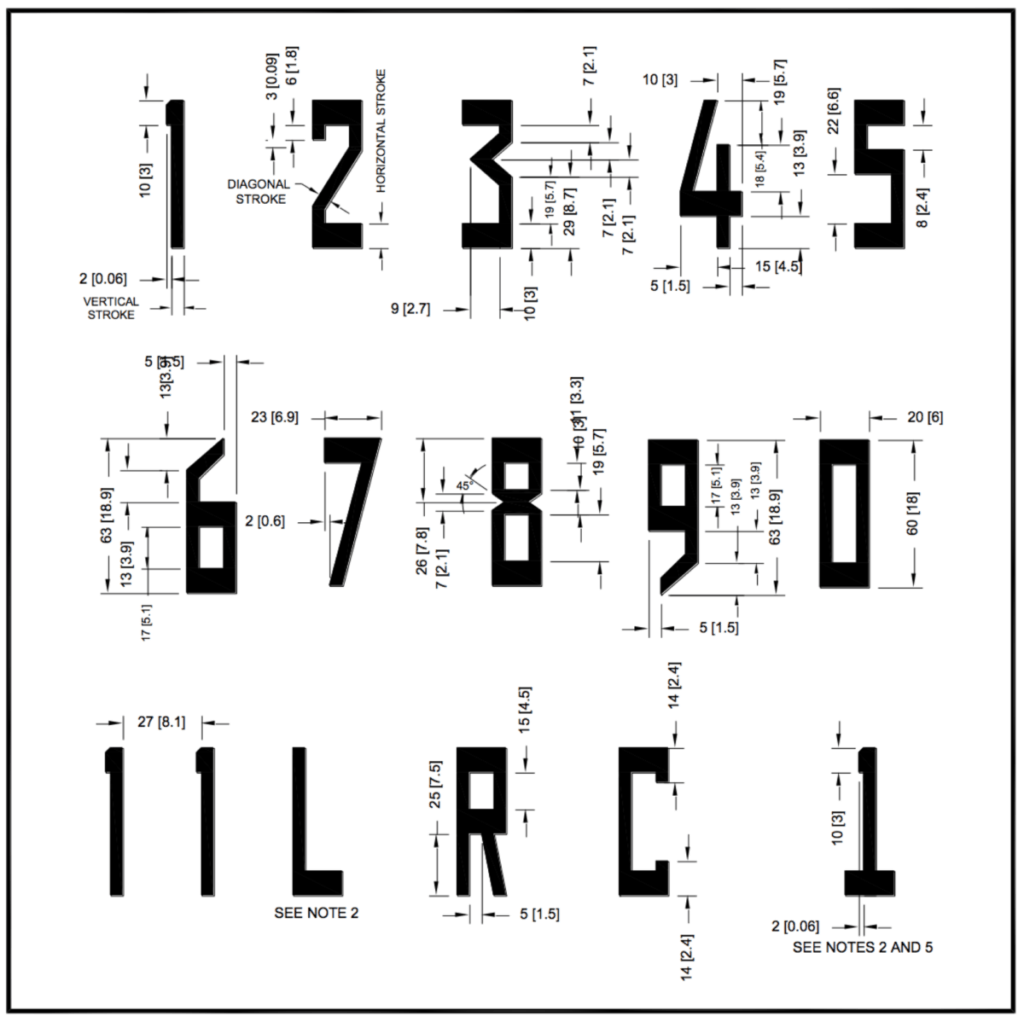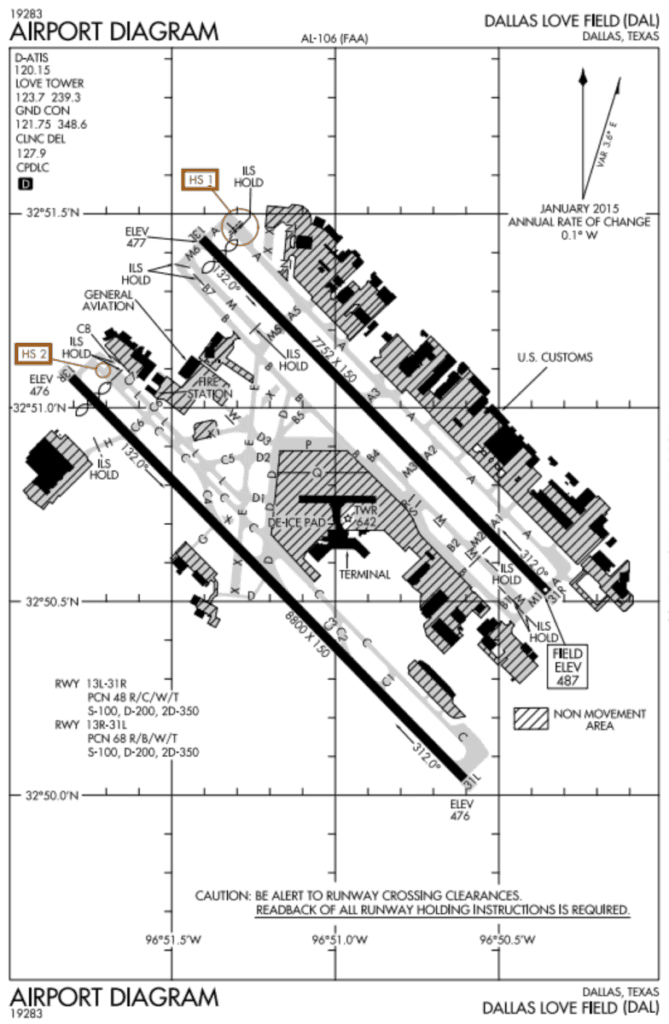
Whether as a passenger on an airliner, or a student pilot in the cockpit, you’ve probably noticed rolling onto the beginning of a runway very large numbers and maybe even a letter painted onto the beginning of the runway. As with everything else in aviation, it’s there for a reason. So what do the numbers and letters on airport runways mean?
The numbers at the beginning of runways denote their magnetic heading, rounded in multiples of ten degrees. For example, runway 18 has a magnetic heading of 180 degrees. Letters (such as 18L, 18R, or 18C) designate that runway’s position relative to parallel runways and can mean left, right, or center.
There are some important implications for runway numbers and lettering, as it’s not just a random number assigned to that runway. We’ll cover in more depth what these numbers and letters mean, how they are chosen, and why it matters.
What do the numbers and letters on runways mean?
All runways at major airports will have a number painted at the beginning of each end of the runway, and also sometimes have a letter at the end of those numbers (covered in a moment). Let’s start with what the numbers mean.
What do the numbers on runways mean?
As mentioned above, the number or numbers on the beginning of each end of the runway stand for that runway’s magnetic heading on a compass, truncated to two digits (multiples of ten).

So, runway 36 faces a magnetic heading of 360 degrees, or due north. Another runway facing 020 degrees in terms of magnetic heading would just be runway 2 (runway 20 would mean 200 degrees, not 020).
These numbers are also rounded, so a runway of 133 magnetic heading would be runway 13.
The FAA has very specific dimensions for the lettering on the runway, as shown below from Advisory Circular 150/5340-1L:

Why Magnetic Heading?
We’ve mentioned magnetic heading several times. Is that designation important?
The short answer is yes. The “why” behind it is pretty interesting but it depends on how deep you want to go.
The medium sized answer is that the North Pole (the geographic “top” of the earth) and the magnetic North Pole that our compasses point to are actually not the same thing, and are in fact several hundred miles apart.
In some parts of the world, the direction to the North Pole vs. the magnetic North Pole (this is called “magnetic variation”) is effectively zero. In other places it can be as much as 15-20 degrees difference (of course, if you were standing right between these two poles the difference would be 180 degrees… but most airports fall somewhere between 0 and 15 degrees of magnetic variation).
Pilots always make use of magnetic headings for several reasons, and so runway directions are always listed in magnetic headings as well.
The long answer is elaborated more in the following posts: What’s the difference between true and magnetic headings? Are winds reported in true or magnetic headings?
What do the letters on runways mean?
Runway numbers can sometimes have L, R, or C beside or beneath the letters, which designates that there are parallel runways on the airport. Since runways are always referred to by their direction, you wouldn’t want to have both runways just referred to as, for example, runway 18 and 18.
Instead, each runway direction will be given an L or and R (left or right, from the perspective of looking in the direction of the runway). If there are three parallel runways one of them will be C, for center.
It’s worth noting that for runway 18L, if you were taking off the other direction and using that same runway, that’s actually 36R, not 36L. Remember that the runway lettering for left or right is in the perspective of looking down the runway.
Take a look at Dallas Love Field (identifier KDAL – see also “Why do some airports start with ‘K’?”) below. It has runways 13L and 13R, which going the other direction are 31R and 31L. Remember that runways always have their reciprocal 180 degree heading as well. So it would be runway 13L/31R, and 13R/31L (130 degrees, or runway 13, plus 180 degrees around a compass is 310, or runway 31).

You’ll have to look very close but you can see at the start of each runway (the long black thick lines) there are runway designations showing 31L, 31R, 13L, and 13R. In the top right, you can see the magnetic variation displayed as 3.6 degrees.
The diagram has the runways correctly shown in terms of their headings as if a compass rose was drawn on top of the airport, and so the runways accurately face southeast (13L and 13R) and northwest (31R and 31L).
How do they choose the runway directions and numbers?
There are two parts to this question. The first is how do airports decide which direction to build the runways, and the second is how do pilots decide which runway direction to use during takeoff and landing. Answers to both of these directions come down to wind, as pilots always want to take off and land into (yes, into) the wind as much as possible (covered more in moment).
How do they decide what direction to build the runway?
The FAA issued Advisory Circular 150/5300-13A on Airport Design, which provides a very in-depth look at how they decide runway orientations, among other things. But from a very high level perspective the FAA wants to build the runway that “provides the greatest wind coverage with the minimum crosswind coverage.”
Basically, they want a runway that will be “into the wind” as much as possible.
To do this, they prefer to look at 10+ years of wind data for that geography from the National Oceanic and Atmospheric Administration (NOAA), if available, and calculate whether or not a particular runway direction would provide acceptable wind direction and strength variances during 95% of the airport’s operations.
Based on what kinds and sizes of aircraft the runway will serve, there are different Runway Design Code (RDC) groupings that allow for higher crosswinds to still fall within this 95% target.
The advisory circular goes on to say “a crosswind runway is recommended when the primary runway orientation provides less than 95 percent wind coverage. The 95 percent wind coverage is computed on the basis of the crosswind not exceeding the allowable value [per Runway Design Code].”
There are many other factors that go into the runway construction considerations, but wind is a large contributor to the direction the runway will face.
How do you decide what runway to land on?
Airports with control towers will dictate which runway is in use, which is primarily determined by the wind direction.
Airplanes are most efficient when taking off and landing into the wind because it provides better lift. It is able to use the airspeed of the wind to supplement its lift and fly slower over the ground while still generating enough lift to fly.
This is where there are technical differences between indicated airspeed, calibrated airspeed, true airspeed, and ground speed, but that’s for another post.
All of that to say, controllers will measure the wind direction and decide the optimal runway for usage.
There are times, however, where the controllers might intentionally choose a runway that is less optimal based on the winds. For example, my aircraft is based at Addison (KADS) in North Texas. It is very close to Dallas Love Field (KDAL, Southwest Airlines’ headquarters) and DFW International (KDFW, American Airlines’ headquarters).
It is very important for air traffic control at Addison to be landing and departing the same general direction as Love Field and DFW for the general flow in and out of the DFW metroplex.
I have landed or departed several times with a small tailwind at Addison while they switch the runway flow out of Love Field and DFW (it takes a little while to shift them all around because of the inbound and outbound volume). But generally you are landing as much into the wind as possible.
At uncontrolled airports it is up to the discretion of the pilot which runway to use. Generally, this follows the same rule in that you want to take off or land as much into the wind as possible, but there are some exceptions to this:
- Some airports will have a preferred calm wind runway, where anything below 3-4 knots for example will use a particular runway even if that means you have a tailwind.
- Some airports (particularly unpaved airfields) that are heavily sloped will be more optimal to land uphill and take off downhill up to a certain wind speed regardless of its direction.
- Some airstrips have topographic obstacles on one end of the runway which means you take off and land different directions (most airstrips I went into in Idaho are like this).
There can be a lot of considerations for choosing the right runway, but in ordinary circumstances it comes down to the wind direction. Wind direction as reported in the airport’s ATIS, AWOS, or ASOS (basically the weather observation at the airport) is presented in magnetic heading which can be compared to the magnetic heading of your runway options to make the best decision.
Final Thoughts
Runway numbers, letters, and other markings have significant meaning in the aviation world. As with a lot of things in aviation, what might seem complicated or cryptic at first actually carries a lot of common sense behind it and isn’t that difficult once you understand what it means. Next time you’re rolling onto a runway you’ll have a better understanding of why you’re on that one specifically.



